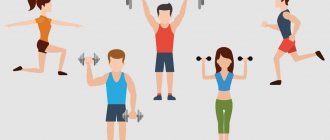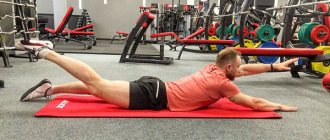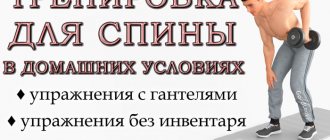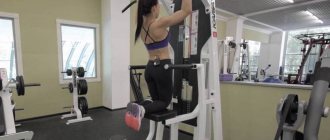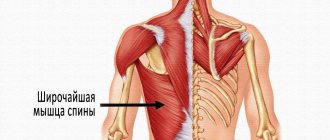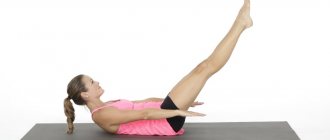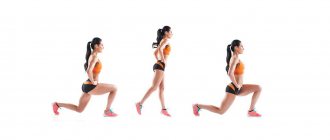The back is one of the most vulnerable parts of the body. In terms of the frequency of problems that arise in this area, it can rival only the knee and hip joints. The main reason is the load on the spine, which persists even at rest (and affects throughout life). Exercises to strengthen the back muscles are not only a tool for developing bulky muscles. This is something that will allow you to maintain health, significantly reduce the risk of injury and significantly improve your quality of life.
How to do back exercises correctly?
Back exercises differ from other exercises in the degree of risk. If you injure your back, then due to the displacement of the support, the spine will be overloaded, organs and blood vessels will be compressed, and this will immediately affect the functioning of the brain.
Before performing the complex, you need to go to the doctor. X-rays and consultation are the minimum that needs to be taken care of.
Safety precautions when performing exercises to strengthen the back are as follows.
- Slow movements. Your task is not to do the complex as quickly as possible, but to feel the muscles working as much as possible.
- Forget about jerking. Sharp lunges, twisting and bending transfer the load to the joint-ligamentous apparatus.
- Progress through more repetitions or difficulty. Exercises with dumbbells are recommended for strong backs. Weak muscles will not be able to lift the weight, so the legs, arms, and abs will be more involved in the work. The complex will cease to be targeted and will be dispersed throughout the body.
- Monitor your health. Stop gymnastics if discomfort occurs. Overcoming yourself through pain will only harm your body.
- Don't exercise on a full stomach. Do exercises before meals or after 2 hours.
The complex is performed every day. Set aside half an hour in the morning and evening for this. A couple of your favorite exercises can be done every hour as a warm-up for your back.
Watch your breath! It should be uniform. We tense the muscles as we exhale, and relax as we inhale. This is an essential condition for the effectiveness of the entire complex.
Before classes, place a special gymnastic mat or blanket on the floor, folded 3-4 times. This will soften the shocks and remove excess stress from the vertebrae.
Second exercise. Blood flow to the spine
This exercise “unwinds” your body, stretches your spine , develops every intervertebral disc , every segment of your spine. Its systematic and regular implementation leads to significant improvements in well-being.
Initial position:
The exercise is performed standing. The arms hang freely along the body. Breathing is free. You don’t have to turn your head to avoid dizziness.
Technique:
- Twist your body in one direction or the other. The arms are relaxed and rotate freely with the body.
- Next, stand with your back to the wall, at arm's length from the wall.
- Turn your body to the sides, trying to move your arm as far as possible, touching the wall.
Who are contraindicated for back exercises?
The training complex is not designed for everyone. There are precautions.
You should not do exercises to strengthen your spine if:
- there is a spinal injury;
- I recently had an operation and the stitches did not completely dissolve;
- there is a period of exacerbation of a chronic disease;
- bleeding is observed;
- there are problems with the kidneys, lungs, heart or blood vessels;
- You are pregnant.
Still want to work on your back? Make an appointment with an orthopedic doctor. He will recommend the safest exercises for you from the repertoire of physical therapy.
Preparation for training
A good warm-up is the key to a safe workout. Unheated muscles and stiff joints can cost your health. Pay special attention to warming up in the morning, because before this the body has been motionless for a long time.
How to warm up?
- Let's wake up the body. Run in place or jump. Now you need to wake up and get your heart pumping.
- We develop joints. Rotate the joints in different directions, starting from the top. We knead the foot like this: bend it slightly in the middle with your fingers back until there is slight discomfort. Rotations are harmful to the neck. We replace them with tilts 10 times in four directions.
- We stretch the muscles. Stretch slightly to the sides so that the muscles become elastic and receive blood flow.
Additional Methods
To increase the effectiveness of home workouts, it is recommended to use additional methods of strengthening the back muscles. Massage works well for this purpose. It is better if it is carried out by a specially trained person, but if it is not possible to invite a professional massage therapist to your home, you can use a rough mitten or a washcloth with a wooden handle. Massage should be done 10-15 minutes after taking a bath or shower.
Massotherapy
Baths with the addition of bergamot oil, contrast showers, and dancing are also beneficial for the back muscles. Don’t forget about nutrition: vegetable oils, cottage cheese, lean meat, eggs, and fish will help maintain muscle strength and maintain back health. These foods contain large amounts of protein, vitamins and essential fatty acids necessary for the growth of myocytes (the cells that make up muscle tissue) and increasing the elasticity of muscle fibers. It is necessary to include these products in the menu daily, taking into account the norm of protein intake for a particular age (for an adult it can range from 60 to 80 g per day).
If you want to learn how to pump your back at home, as well as detailed step-by-step descriptions of the exercises, you can read an article about it on our portal.
Video - How to strengthen your back muscles at home
A set of exercises for the back
The system is designed for intermediate and beginner levels of fitness. Exercises are performed at home without weights. Do up to 15 repetitions, number of approaches: from 1 to 5, depending on your level of fitness.
Bridge with hips
It is often recommended for people with weak supporting structures: proper execution involves muscles to a greater extent than ligaments and joints. Training relieves lumbar pain by strengthening and stretching the back muscles. The work also includes the buttocks, abs and thighs.
How to do it?
- Lie on the floor with your knees bent. The arms are extended along the body, and the back is pressed tightly to the surface.
- As you exhale, strain your buttocks and lift your pelvis up until your hips and chin can be connected by a straight line. At the same time, we slightly round the lower back so as not to overload. The primary movement is made by the pelvis, not the back.
- As you inhale, slightly relax your muscles and lower yourself down.
Keep your muscles tense at all times. Do not throw your body down, but lower it smoothly.
Advanced level: lift your body on one leg, the second is bent at this time and lies on the first leg, the ankle touching the knee.
Dog and bird
The exercise involves the whole body, as you will have to maintain balance. The buttocks will receive an additional stimulus by raising the legs.
How to do it?
- Get on all fours with your arms and legs at 90 degrees to your body. Place your hands shoulder-width apart.
- Tighten your core muscles so that your back is completely straight. The shoulder blades are slightly brought together, the gaze is directed downwards.
- Simultaneously lift and extend your left arm and right leg. They should be parallel to the floor.
- Hold the tense position slightly.
- Smoothly step back and switch arms and legs.
You can make the exercise more difficult by spending more time at the point of maximum tension. Isotonic exercise simultaneously trains and stretches the muscles, increasing blood flow. Try standing with your leg and arm raised for 5-10 seconds, sway slightly while maintaining your balance.
Side plank
One of the most difficult exercises even with your own weight. The effect is comparable to training in the gym. It differs from a regular plank in the increased load on one side and the powerful development of the oblique abdominal muscles, which are responsible for supporting the back and creating a thin waist.
How to do it?
- Lie on your side, resting on your elbow. The hand is extended forward and pressed to the floor, creating additional support. The second hand rests on the waist.
- Place your legs on top of each other, with only one touching the floor.
- Straighten your back and tighten your stomach.
- As you exhale, lift your body off the floor and lift it up. The ideal option is the body as a straight line.
- Hold the plank position for a few seconds and slowly lower yourself to the floor.
The support is on the arm and leg. A sagging belly is a problem that can cost the health of your spine.
For beginners, a plank on your side with your legs bent at the knees is suitable. This increases the area of support, which helps maintain balance.
The difficulty is also increased by standing in the plank position longer. Hold your back straight for 10-20 seconds and you won't need dumbbells.
The most difficult option: when lifting the body, we also raise the upper arm and leg. They are in a position of 45 degrees relative to the body.
Lunges
About 90% of people believe that lunges are an exercise for the buttocks. However, this movement involves the whole body, including the back - it holds the body, preventing it from collapsing. The lower back and front of the thigh will receive most of the load.
How to do it?
- Stand straight, your feet are in a medium position, your hands are on your waist.
- Inhale and take a step forward. The weight is transferred to that leg and placed evenly across the entire foot. Make sure your body is straight. The back leg rests only on the toes, and the knee almost touches the floor.
- As you exhale, direct your center of gravity to your back leg and straighten your front leg. Return to the starting position.
When lunging forward, do not drop the knee of the back leg to the floor - the kneecap is fragile. Gently lower your leg and stay one and a half cm to the floor.
Keep your lower back straight and do not touch your stomach with your legs. If it’s difficult, then slightly tuck your back forward, the main thing is to not let your abs sag. Also keep your head straight, your gaze directed forward.
Place your feet shoulder-width apart, not in a straight line. This will make it easier for you to maintain balance and protect yourself from injury.
Stretching on a fitball
Our back bends forward during the day. The lower back is clamped in one position, so it starts to hurt. Exercises on a fitball compensate for this by creating a backbend and relieving tension.
There are several options for stretching on an exercise ball. Let's look at the two most effective ones.
Exercise for the deep lumbar muscles.
- Rest your stomach on the ball. The legs are wide apart, straight and resting on the floor with their toes. Arms are parallel to the body.
- As you exhale, lift your body up, straightening your shoulders. Try to reach higher.
- Inhale and come back.
Bridge on a fitball to strengthen the back muscles.
- Lie with your back on the ball. At the same time, your arms and legs must rest on the floor, maintaining balance. The calves are pressed against the ball.
- Gently roll the ball under your back. The spine is tightly pressed to the fitball; there should be no gaps or unnecessary deflections.
- Try staying on the bridge for a few seconds.
The exercise is safer than the classic version without an exercise ball. The muscle corset is formed gradually, without overload.
Baby pose
The exercise comes from yoga. Great for relaxing after a workout and during the work day. The muscles tense slightly and stretch more. The muscles most involved are the erector spinae and the lower back. During sedentary work, these muscles contract 90% of the time, which causes back pain.
When the intervertebral discs are stretched, they return to their normal position. Excessive pressure is removed from the nerves and blood vessels, and the influx of fresh blood saturates the body with oxygen.
How to do it?
- Get on your knees.
- Place your body down on your knees and relax. The head rests on the floor with the forehead or temple.
- Stretch your arms along your body without straining them.
- Make sure your shoulders and neck are also relaxed.
- Hold the pose while breathing deeply. As you exhale, relax the muscles one by one from bottom to top: first your feet, then your calves, thighs, etc.
- Slowly return to a kneeling position.
Due to deep breathing, the abdominal organs receive a light massage. This increases blood flow and improves their functions.
First exercise. Cervical region
Working with the cervical spine normalizes intracranial pressure, improves memory, hearing, vision, and increases performance . The vestibular apparatus is gradually restored, sleep becomes normal, the condition of the thyroid gland improves, numbness in the hands is eliminated, and overall brain nutrition improves. This exercise is extremely simple; anyone, even an untrained person, can do it.
Safety precautions: This exercise can be done by people with herniated intervertebral discs. All movements are performed smoothly. The effort increases gradually. Don't cause it to hurt! There should only be a feeling of pleasant tension in the neck area, do not allow overexertion.
Attention! You may hear a few clicks. Don't be afraid of this.
Technique:
- Place your left hand on your right temple.
- Pull your head effortlessly towards your left shoulder.
- Then place your right hand on your left temple.
- Pull your head towards your right shoulder.
Next, do the simplest impact on the neck muscles.
- Place one foot on a chair.
- Place your elbow on your knee.
- Place your chin on your palm.
- And carefully, turn your head to the side, resting on your palm.
- Then place your other leg on the chair and repeat in the other direction.
Prevention of back pain
Don't expect sharp pain, take care of your back in advance. All prevention is based on compliance with traffic rules.
- Watch your posture.
- Stretch regularly: Our bodies are not designed to sit constantly.
- Sit with your back straight in an appropriately sized chair.
- Don't strain yourself by carrying heavy things.
- Exercise; For busy people, our complex is suitable for half an hour.
If you have back problems, visit an orthopedic doctor at least once every six months. He will track the dynamics of your condition and help correct it. A healthy back is the key to the health of the whole body!
